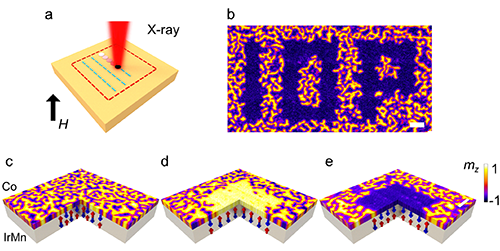X-ray-induced zero-field skyrmion and 2D artificial skyrmion crystal
Date:14-04-2020 Print
Magnetic skyrmions show promise for next-generation magnetic recording devices with high energy efficiency and high density due to its nanoscale size and low driving current density. Precise creation of single nanoscale skyrmions is the prerequisite to study their physical properties and develop related devices. Recently, Ph.D. student Yao Guang, Dr. Yizhou Liu, Associate Prof. Guoqiang Yu, Prof. Xiufeng Han, et al., from the State Key Laboratory of Magnetism, Institute of Physics, Chinese Academy of Sciences, in collaboration with Prof. Gisela Schütz's group at the Max Planck for Intelligent Systems, Prof. Y. Tserkovnyak's group at the University of California Los Angeles, and Prof. Yong Peng's group at Lanzhou University, use a soft X-ray magnetic imaging technology with a high spatiotemporal resolution to successfully induce skyrmions with about 100 nm in size at room temperature. The mechanism of skyrmion creation is dominated by the X-ray-induced exchange bias reorientation effect. In addition to creating a single skyrmion, they also utilize X-rays to generate two-dimensional artificial skyrmion crystals with various structures.
In this research, a scanning transmission X-ray microscope (STXM) was used to systematically study the structure of [Pt/Co/IrMn]n multilayers with exchange bias. It was first discovered that the X-ray illumination can reorient the antiferromagnetic order. In addition, the high spatial resolution optical control of the antiferromagnetic order and the coupled ferromagnetic order are also realized. Taking advantage of this phenomenon, the team first successfully created a single-domain with arbitrary shapes at zero external magnetic field under the background of the labyrinth domain, as shown in Figure 1. Using X-rays to scan specific small-size regions in a single-domain area can accurately locate and create a single skyrmion. Furthermore, through large-area site scanning, the skyrmion crystals were successfully constructed, including triangle, square, and kagome lattices (Figure 2).

Fig 1. a. X-ray induced exchange bias reorientation effect. a Sketch of using synchrotron X-rays to introduce a uniform exchange bias through scanning a closed area (dashed lines) under a perpendicular magnetic field (H), The magnetic field indicated by the arrow is along the positive direction. b The logo of IOP at zero-field are patterned after scanning by synchrotron X-rays. c-e Schematics of the three-quarter sectional cut of the STXM data and the corresponding exchange bias. The arrows in the IrMn layer schematically indicate the antiferromagnetically ordered net magnetization in the out-of-plane direction. The white scale bar in b, e is 1 μm.
This study provides a new pathway for modifying antiferromagnetic structure and further realizes antiferromagnetic skyrmion in the exchange bias system. Due to the short wavelength characteristics of X-rays, this method is expected to be used to manipulate antiferromagnetism with a spatial resolution smaller than 10 nm, which significantly improves the spatial resolution of the optically controlled magnetism. This research can also attract more attention on the use of X-ray methods to manipulate magnetic order, and further promote high spatial resolution optical control of magnetic order in magnetic materials.

Fig 2. X-ray-induced creation of single skyrmion and artificial skyrmion crystals. a Magnetic domain pattern after introducing a uniform exchange bias in the middle channel (dashed area). b Two skyrmions are accurately created on a single domain area with controlled X-rays. c-d Triangular skyrmion lattice and square skyrmion lattice writing by X-rays in the single domain area. The scale bar in b is 1 μm.
Related work has been published in Nature Communications [Y. Guang, I. Bykova, Y. Liu, G.Q. Yu, E. Goering, M. Weigand, J. Gr?fe, SK Kim, J. Zhang, H. Zhang, Z Yan, C. Wan, J. Feng, X. Wang, C. Guo, H. Wei, Y. Peng, Y. Tserkovnyak, X.F. Han, G. Schütz, Nat. Commun. 11 (2020) 949].
The work was supported by the Ministry of Science and Technology of China, the National Science Foundation, Beijing Natural Science Foundation, and the Chinese Academy of Sciences.
Article link:https://www.nature.com/articles/s41467-020-14769-0


